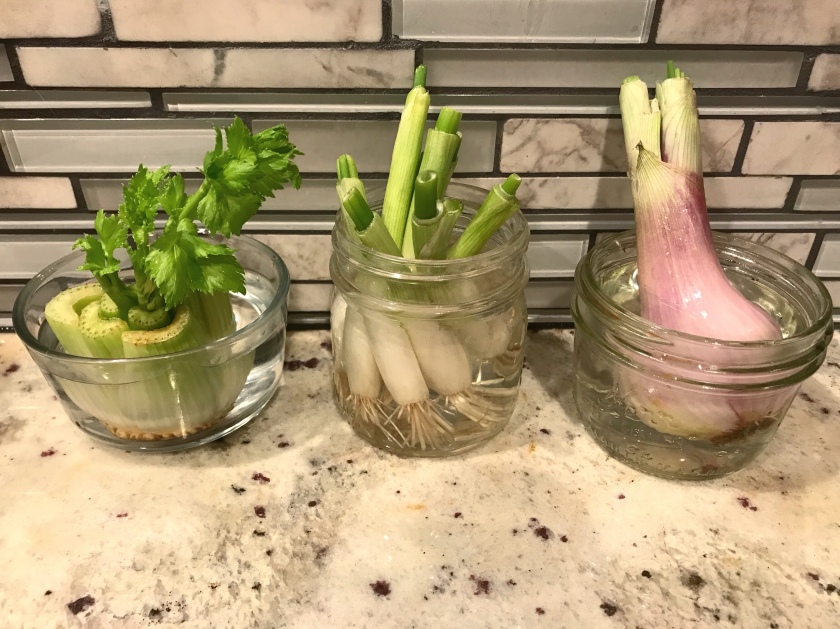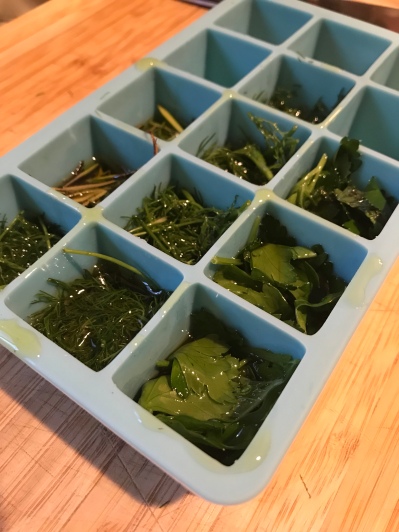
Did you know some of the best ways to store vegetables like celery, asparagus and herbs is up right in a glass of water in the fridge? Here are some more helpful produce storage tips to help you reduce food waste!
Apples: Fresh, apples can last a little over a week at room temperature, out of direct light. However, apples can last over three weeks in the crisper drawer in the fridge. You can also make and freeze your own apple sauce to have on hand for later!
Avocados: To ripen avocados, place in a paper bag. (Tip: reuse the paper bag for microwave popcorn!) Avocado a little too ripe? Don’t waste it! It’s the perfect time to make nutrient-rich hair mask.
Storage: say you cut an avocado in half and want to save the other half, place it in a sealed container or reusable bag with a couple pieces of purple onion. Note: this will give the avo a mild onion flavor, but it will still work well for many dishes, especially guacamole which already has onion in it.
Freezing: you can freeze an avocado but it will probably work best for smoothies. I prefer a cold smoothie, so sometimes I freeze the avocado anyway instead of adding ice. I cut the avo in half, peel off the skin, remove the seed, and lay flat on a plate in the freezer until frozen. For longer storage, freeze in a sealed container.
Bananas freeze WONDERFULLY. If they’re ripening faster than you can consume them, peel them, cut them into chunks, and freeze them. Frozen bananas are PERFECT for smoothies. Thaw the bananas and use in your favorite bread, muffin or cake recipe!
Berries: With the exception of strawberries that can last about a week in the fridge, berries have a wash-and-eat fast policy. If you don’t plan on eating them quickly, freeze them. They make perfect additions to smoothies or homemade sorbets.
Celery: cut the end off the celery and rinse in water. Place up right in a jar like a flower bouquet and fill with water. Store in the fridge and top up the water as necessary. If it’s starting to go limp, you can chop the celery and freeze it and then have it on hand for soups and stocks.
Carrots: washed and cleaned, carrots store best in the crisper drawer. You can cut and freeze carrots to use later in soups. Unlike other vegetables, you do not need to blanche these before freezing.
Cucumbers: Can last up to a week in the crisper drawer. Pickle them and they can last for months! Do not freeze! If you need to store a cut cucumber, use beeswax wrap or a mason jar.
Herbs: many herbs like basil, fennel, spearmint, and even rosemary can be stored up right in a glass of water in the fridge. Or chop up and cover in your favorite cooking oil and freeze in ice cube trays:

This is great for soups, sauces, and even dips! Thanks for the tip Eco Granny!
Garlic: likes a well ventilated, cool area. If it starts to sprout, garlic can easily be planted in, even in a potted container, for flowers and future garlic! Peeled and minced garlic can be frozen!
Ginger: Same as ginger! Ginger can be grated directly from the freezer. Ginger can also be replanted!
Grapes: Grapes can last a few weeks in the fridge and they can also be frozen for a cool treat on a hot afternoon. Zero Waste Hack: frozen grapes make great ice cubes!
Greens: Most greens do best in the crisper drawer. Check out this AWESOME method on storing lettuce zero waste style, here.
Leeks: Store in the fridge unwashed for up to two weeks.
Lemon: Say you need to juice half a lemon. After cutting the lemon in half, cut the a chunk of the end off the piece your going to juice. With a toothpick, you can re-attach the end to the other half of the lemon and preserve it in the fridge a few days longer before it dries out. Remember, save your lemon peels to enhance the aroma of your All Purpose Cleaning Spray, to flavor your tea, or you even use them to make lemon peel candy!
Lettuce: Rinse the lettuce under water to remove and dirt and debris. Then wrap in a clean, damp towel and place in the crisper drawer in the fridge.
Onions: in a cool, well ventilated area, like a basket in a cabinet. Onions can be chopped up and frozen to use in future sauces and soups.
Potatoes in a dark cabinet, in something well ventilated like a basket. Don’t store potatoes next to onions! The gasses each release cause the other to spoil faster! (Don’t store apples with potatoes for the same reason!)
Spaghetti Squash: spaghetti squash can last at room temperature for up to three months! Don’t refrigerate! It will spoil in two weeks in the fridge!
Strawberries: Strawberries will last for a week in the fridge. Otherwise, cut off the stems, cut the larger berries in halves, and freeze to add to future smoothies or homemade sorbet.
Summer Squash: In the crisper drawer of the fridge, this will last about a week.
Sweet Potatoes: can be frozen after boiling them a bit. First, cut them into 1 inch cubes, then boil for about ten minutes on high heat. Strain, and allow the potatoes cubes to return to room temperature. Place in a sealable glass container and freeze. When ready, you can thaw them and use them for pie, pastries, cakes, or breads.
Alternatively, you can also freeze mashed sweet potatoes. Allow them to return to room temperature and pack into in a sealable glass container, leaving 1/2 of room on top. Use within twelve months.
Tomatoes: Ripe tomatoes can be stored at room temperature out of direct sunlight. Once they become soft, tomatoes will last in the fridge for two to three more days. But as my dad says, that kills the taste. When you’re ready to use them again, let the tomatoes come back to room temperature, this will bring back some of that yummy flavor. The best way to use up tomatoes is to make your favorite pasta or pizza sauce and freeze it where it will last for months!
Zucchini/Courgettes: In the crisper drawer of the fridge, this will last about a week. Zucchini can be blanched and frozen, but I never had a lot of success with this. My favorite method is to make zucchini bread or muffins, which freeze great and last months!
Anything you want to know about? Drop me a comment and I’ll research the best storage options for your produce!

This Storing Produce – Zero Waste California site has helped me many times in health problems.
This book helped me to heal and feel better: https://s96.me/herbal-remedies
Kiss you all!
LikeLike
This Storing Produce – Zero Waste California site has helped me many times in health
problems. This book helped me to heal and feel better: https://s96.me/herbal-remedies Kiss
you all!
LikeLike